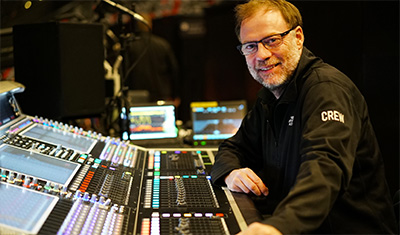Having begun his live sound career in theatre aged 16, FOH engineer Simon Thomas has worked with the likes of Gary Numan, Echo and the Bunnymen, Moby, Tracy Chapman, Kylie Minogue, Jessie J and Sam Smith in the intervening 34 years. Most recently, he has been out with Ariana Grande.
Based around a DiGiCo SD7 mixing console, the FOH rig for the Dangerous Woman Tour was inherited from previous engineer Toby Francis, and was Thomas’ first experience with Rupert Neve Designs equipment.

The all-analogue outboard set-up included a 5059 Satellite summing mixer, a Shelford Channel for lead vocals, and a Portico II Master Buss Processor on the two-bus. ‘In very simple terms, the analogue thing brings the mix forward, brings it out of the box – rather than making it feel stuck in the box, where it lacks impact,’ he reports.
He sent seven groups from his DiGiCo SD7 console into the 5059, including drums, band/tracks, backing vocals and lead vocals. The Shelford Channel was used on Grande’s vocals: ‘It’s good to have a piece of equipment at hand that you can just grab rather than digging into the digital domain,’ Thomas says. ‘The EQ was pretty sensitive, and I didn’t have to do much to resolve a problem – a couple of clicks and you could deal with any top-end nonsense going on in the PA.’
Thomas also reports that the unit’s diode bridge compressor worked quite well as a He tool. ‘I would’ve never thought to have used that idea in the first place, but in saying that, it worked.’
Thomas had first heard about the Master Buss Processor when out on tour with Sam Smith, but couldn’t get his hands on one at the time. ‘It’s my new favourite bus compressor – it just brings depth, brings out the snare drum – it brings things forward. It’s one of those bits of kit that I wish had been around for years.’
Both the Red and Blue Silk settings on the Master Buss Processor were used depending on the show, with Silk Blue adept at taming overly bright PA systems. ‘When ratios are lower, I used the Blue function to tweak it a little bit,’ Thomas says. ‘But when I was using higher ratios, I used Silk Red to bring some of the air back into it.’
‘I don’t think analogue is going to go away,’ he reflects. ‘People tried to do that, and realised it doesn’t actually work like that. What we’re starting to be able to achieve now is almost that “studio sound” in the live environment. Every industry needs to reinvent itself, and that’s progress – but at the end of the day, people still have analogue ears.’
More: http://rupertneve.com














